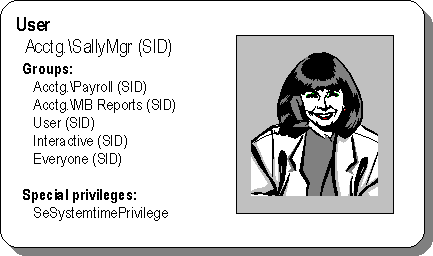
Users are identified to the system by a unique security ID (SID). Security IDs are unique across time and space, meaning that there is no possibility of having two identical security IDs. For example, suppose Sally, who has a Windows NT account, leaves her job at a company but later returns to a different job at the same company. When Sally leaves, the administrator deletes her account, and Windows NT no longer accepts her security ID as valid. When Sally returns, the administrator creates a new account, and Windows NT generates a new security ID for that account. The new security ID does not match the old one, so nothing from the old account is transferred to the new account.
When a user logs on, Windows NT creates a security access token. This includes a security ID for the user, other security IDs for the groups to which the user belongs, plus other information such as the user's name and the groups to which that user belongs. In addition, every process that runs on behalf of this user will have a copy of his or her access token. For example, when Sally starts Notepad, the Notepad process receives a copy of Sally's access token.
Figure 2.3 illustrates the contents of an access token.

Figure 2.2 Access Token Contents
Windows NT refers to the security IDs within a user's access token when he or she tries to access an object. The security IDs are compared with the list of access permissions for the object to ensure that the user has sufficient permission to access the object.